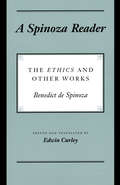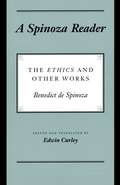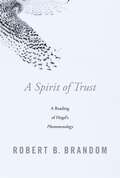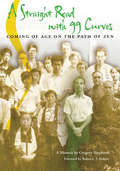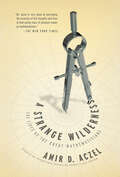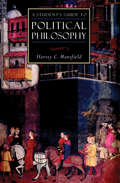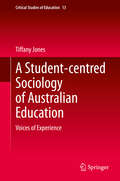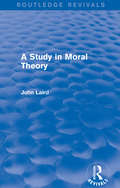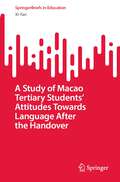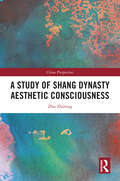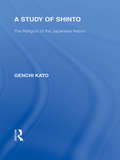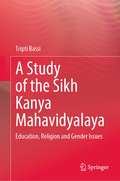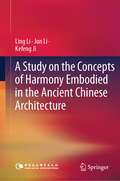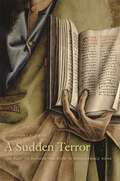- Table View
- List View
A Spinoza Reader: The Ethics And Other Works
by Benedictus De Spinoza Edwin M. CurleyThis anthology of the work of Baruch de Spinoza (1632-1677) presents the text of Spinoza's masterwork, the Ethics, in what is now the standard translation by Edwin Curley. Also included are selections from other works by Spinoza, chosen by Curley to make the Ethics easier to understand, and a substantial introduction that gives an overview of Spinoza's life and the main themes of his philosophy. Perfect for course use, the Spinoza Reader is a practical tool with which to approach one of the world's greatest but most difficult thinkers, a passionate seeker of the truth who has been viewed by some as an atheist and by others as a religious mystic. <P><P> The anthology begins with the opening section of the Treatise on the Emendation of the Intellect, which has always moved readers by its description of the young Spinoza's spiritual quest, his dissatisfaction with the things people ordinarily strive for--wealth, honor, and sensual pleasure--and his hope that the pursuit of knowledge would lead him to discover the true good. The emphasis throughout these selections is on metaphysical, epistemological, and religious issues: the existence and nature of God, his relation to the world, the nature of the human mind and its relation to the body, and the theory of demonstration, axioms, and definitions. For each of these topics, the editor supplements the rigorous discussions in the Ethics with informal treatments from Spinoza's other works.
A Spinoza Reader: The Ethics and Other Works
by Benedictus de SpinozaThis anthology of the work of Baruch de Spinoza (1632-1677) presents the text of Spinoza's masterwork, the Ethics, in what is now the standard translation by Edwin Curley. Also included are selections from other works by Spinoza, chosen by Curley to make the Ethics easier to understand, and a substantial introduction that gives an overview of Spinoza's life and the main themes of his philosophy. Perfect for course use, the Spinoza Reader is a practical tool with which to approach one of the world's greatest but most difficult thinkers, a passionate seeker of the truth who has been viewed by some as an atheist and by others as a religious mystic. The anthology begins with the opening section of the Treatise on the Emendation of the Intellect, which has always moved readers by its description of the young Spinoza's spiritual quest, his dissatisfaction with the things people ordinarily strive for--wealth, honor, and sensual pleasure--and his hope that the pursuit of knowledge would lead him to discover the true good. The emphasis throughout these selections is on metaphysical, epistemological, and religious issues: the existence and nature of God, his relation to the world, the nature of the human mind and its relation to the body, and the theory of demonstration, axioms, and definitions. For each of these topics, the editor supplements the rigorous discussions in the Ethics with informal treatments from Spinoza's other works.
A Spirit of Trust: A Reading of Hegel’s <i>Phenomenology</i>
by Robert B. BrandomIn a new retelling of the romantic rationalist adventure of ideas that is Hegel’s classic The Phenomenology of Spirit, Robert Brandom argues that when our self-conscious recognitive attitudes take Hegel’s radical form of magnanimity and trust, we can overcome a troubled modernity and enter a new age of spirit.
A Spiritual Formation Journal: A Renovare Resource for Spiritual Formation
by Richard J. Foster Jana ReaSpiritual study groups have never been more popular among Christians of all denominations. Coming together to study, pray, and plan ways to serve the community can spark new ideas and deeper reflection in each member of the group. A Spiritual Formation Journal, designed specifically to complement both individual and small group contemplation, is the perfect place to further explore these ideas and carry them into our everyday lives.As part of Renovaré's popular collection of resource books, A Spiritual Formation Journal is uniquely designed with an emphasis on five great Christian traditions: Contemplative, the Prayer-Filled Life; Holiness, the Virtuous Life; Charismatic, the Spirit-Empowered Life; Social Justice, the Compassionate Life; and Evangelical, the Word-Centered Life. Divided into weekly sections, the journal offers an inviting space for written reflection and prayer as well as inspiring quotes, thought-provoking questions, evaluation exercises, and group worksheets to encourage the examination and celebration of spiritual growth.
A Straight Road with 99 Curves
by Gregory Shepherd Ruben Lf Habito"Deeply involving, instructive, and capable of touching any reader who cares about the search for meaning."-Mitch Horowitz, author of Occult America"In being so frank about his own struggles and fantasies, Greg's personal tale becomes something more universal."-David R. Loy, author of Money, Sex, War, Karma: Notes for a Buddhist RevolutionIn 1971, when Greg Shepherd was in his early twenties, he left New Jersey and joined the Koko An Zendo community in Hawaii. What began as a quest for enlightenment became Greg's confrontation with his own inner demons: his need for approval, his distrust of authority, and his ego-driven fixation on achieving the profound spiritual breakthrough of kensho ("the Big K"). Later, in Japan, he struggled with prejudice and cultural rigidity and found his deeper meditations leading to actual panic attacks over fear of losing himself. Ultimately, he broke with Zen and his teachers to pursue a career in music.This frank memoir traces Greg Shepherd's meandering path from seeker to disillusionment, and, over a decade later, his way back to Zen and inner peace. We experience Zen practice in Japan and Hawaii and meet Zen masters Yamada Koun Roshi and Robert Aitken, the "dean of American Buddhism" (who had once pegged Greg as his successor). And we understand why Zen was so appealing to the American counterculture and how its profound lessons of focus and detachment remain insightful and important.Gregory Shepherd has studied Zen since the early 1970s in Hawaii and Japan. He is associate professor of music at Kauai Community College.
A Strange Goodness?: God and Natural Evil
by Stephen AmesThis book is about all the suffering and death produced by natural processes like tsunamis, genetic disorders, extreme weather events, even before climate change, and the whole evolutionary process leading to all living things on the planet. (The book is not about the violence men and women wilfully do to each other and to the planet). Many people find all this suffering and death due to natural processes hard to reconcile with the belief that these natural processes are created by a God who is all powerful, all knowing and wholly good. They expect such a God to create a different kind of universe without such suffering and death. The actual universe contradicts the universe expected. This is good enough reason for many people to decide to give up believing in God who is the creator of these natural processes. The book is an invitation for people to revisit that decision. The book comes from the author co-designing and co-lecturing with his atheist colleagues in History and Philosophy of Science at The University of Melbourne, a second-year subject, 'God and the Natural Sciences'. This took place over twenty years. Students with a wide variety of beliefs, enrolled in the subject from across the university. The book has three chapters. The first clarifies the problem in the problem of natural evil to ensure we are not talking past each other. The second chapter gives my answer to the problem of natural evil. I argue from this idea of God to the kind of universe we should expect God to create. The expected universe is found not to contradict the actual universe. The third chapter is 'Reality Checks', nine ways of testing the account of the kind of universe we should expect God to create. The book has an appendix where I discuss alternative ideas of God that are in circulation and address several other criticisms of the idea of God besides the problem of natural evil.
A Strange Stirring: The Feminine Mystique and American Women at the Dawn of the 1960s
by Stephanie CoontzIn 1963, Betty Friedan unleashed a storm of controversy with her bestselling book, The Feminine Mystique. Hundreds of women wrote to her to say that the book had transformed, even saved, their lives. Nearly half a century later, many women still recall where they were when they first read it. In A Strange Stirring, historian Stephanie Coontz examines the dawn of the 1960s, when the sexual revolution had barely begun, newspapers advertised for "perky, attractive gal typists," but married women were told to stay home, and husbands controlled almost every aspect of family life. Based on exhaustive research and interviews, and challenging both conservative and liberal myths about Friedan, A Strange Stirring brilliantly illuminates how a generation of women came to realize that their dissatisfaction with domestic life didn't reflect their personal weakness but rather a social and political injustice.
A Strange Wilderness: The Lives of the Great Mathematicians
by Amir D. Aczel“Mathematics is not a careful march down a well-cleared highway, but a journey into a strange wilderness, where the explorers often get lost.”-- Mathematics historian W. S. Anglin From the internationally bestselling author of Fermats Last Theorem comes a landmark publication on the eccentric lives of the foremost mathematicians in history..From Archimedes eureka moment to Alexander Grothendiecks seclusion in the Pyrenees, bestselling author Amir Aczel selects the most compelling stories in the history of mathematics, creating a colorful narrative that explores the quirky personalities behind some of the most groundbreaking, enduring theorems. This is not your dry “college textbook” account of mathematical history; it bristles with tales of duels, battlefield heroism, flamboyant arrogance, pranks, secret societies, imprisonment, feuds, theft, and some very costly errors of judgment. (Clearly, genius doesnt guarantee street smarts.) Ultimately, readers will come away entertained, and with a newfound appreciation of the tenacity, complexity, eccentricity, and brilliance of the mathematical genius.
A Student's Guide to American Political Thought (ISI Guides to the Major Disciplines)
by George W. CareyA concise overview of the competing political philosophies that have shaped United States history. Who are the most influential thinkers, and which are the most important concepts, events, and documents in the study of the American political tradition? How ought we regard the beliefs and motivations of the founders, the debate over the ratification of the Constitution, the historical circumstances of the Declaration of Independence, the rise of the modern presidency, and the advent of judicial supremacy? These are a few of the fascinating questions canvassed by George W. Carey in A Student&’s Guide to American Political Thought. Carey&’s primer instructs students on the fundamental matters of American political theory while telling them where to turn to obtain a better grasp on the ideas that have shaped the American political heritage.
A Student's Guide to Philosophy: Philosophy (ISI Guides to the Major Disciplines)
by Ralph M. McInernyA powerful essay on the pursuit of wisdom, with recommendations for further reading.A Student&’s Guide to Philosophy examines these questions: Who is a philosopher? Can philosophical thought be avoided? What have philosophers written over the ages? And why should we care? In this critical essay, these and other questions are posed and answered by one of America&’s leading philosophers, Ralph McInerny of the University of Notre Dame. Schools of thought are examined with humor and verve, and the principal works of philosophers and scholars are recommended.
A Student's Guide to Political Philosophy (ISI Guides to the Major Disciplines)
by Harvey C. MansfieldA primer on the bedrock principles of politics from &“Harvard&’s most controversial conservative professor&” and the author of Democracy in America (Boston magazine). Behind the daily headlines on presidential races and local elections is the theory of the polity—or what the end of our politics should be. Harvard&’s Harvey C. Mansfield, one of America&’s leading political theorists, explains why our quest for the good life must address the type of government we seek to uphold. He directs our gaze to the thinkers and philosophies and classic works that have proved most influential throughout the ages.
A Student-centred Sociology of Australian Education: Voices of Experience (Critical Studies of Education #13)
by Tiffany JonesThis book is based on a comparative study from 2018, of four different approaches to education, according to 2,500 Australians’ experiences of them, on a range of topics. It shows that whilst the critical approach has strong research-based support across the board, sometimes a liberal, conservative or post-modern approach may have some merit for certain outcomes. This is a book about challenging our biases and calling on ourselves to aim higher for education, than what our own pre-conceived ideas might allow. What and who is valued in education, and the social roles and identity messages learned, differ wildly from school to school. Education is most impacted by the orientation of education dominant in that context – whether conservative, liberal, critical or post-modern. These terms are often used with little practical data on the real-life schooling they entail. Who learns what in which approach? Who learns best with which approach, on which topic and why? This book provides this previously missing information. It offers holistic, detailed descriptions of conservative, liberal, critical and post-modern approaches to education broadly. It provides statistics and stories from real students on how the four approaches work practically in schools in relation to: age, gender, sexuality, social class, race, news-media, popular culture and technology. Chapters offer background information to the four perspectives, data from student participants, tutorial questions and activities, and suggestions for further reading.
A Study in Moral Theory (Routledge Revivals)
by John LairdFirst published in 1926, this study addresses the theory of morality using four overarching approaches: analytical, psychological, theoretical, and finally, philosophical. Within these methodologies, chapters explore such areas as the character of moral enquiry, the knowledge of good and evil, freedom and self-determination and moral philosophy. This is an interesting reissue, which will be of particular value to students researching the philosophy of ethics and morality.
A Study in the Philosophy of Malebranche (Routledge Revivals)
by Ralph W. ChurchFirst published in 1931, A Study in the Philosophy of Malebranche examines the theories which constitute the philosophical system of Malebranche. From the entire gamut of Malebranche’s works, Church specifically culls out and analyses theories pertaining to Malebranche’s vision in god; knowledge; occasionalism; and imagination and sense. These theories are embedded within Malebranche’s lifelong engagement with the works of Descartes and to some extent, St. Augustine. A philosopher often overlooked, A Study in the Philosophy of Malebranche has enduring relevance for students of philosophy and theology.
A Study of Macao Tertiary Students’ Attitudes Towards Language After the Handover (SpringerBriefs in Education)
by Xi YanThis book focuses on the attitudes of Macao tertiary students toward language after the handover. It shares the findings of a questionnaire survey and semi-structured interviews, which were conducted among freshmen of the University of Macao to investigate their attitudes toward Cantonese, Putonghua, English, and Portuguese, as well as their attitudes toward Macao's language planning and language policy. Utilizing a multidimensional and multilayered perspective in the study, this book also demonstrates the orientations of Macao tertiary students and the correlation between their social categories (gender and social class) and their attitudes toward language.
A Study of Marx’s View of History: To the Depths of History (Understanding China)
by Xianda ChenThis book summarizes the process of Marx’s foundation of the view of history into two turning points, namely, from alienation to alienated labor, and then from alienated labor to the materialistic view of history. Meanwhile, this book makes an in-depth analysis of the ideas about the materialistic view of history in recent years, which is conducive to further clarifying the ideas of Marxist learners and researchers. Besides, this book, on the basis of the human exploration of historical laws, analyzes how Marx broke through the limitations of previous historical views and went deep into history, that is, the process of discovering the laws of history itself, thus profoundly revealing the important reference value of Marx’s view of history in the transformation of human historical views. It is also conducive to building a bridge of communication between Chinese and Western philosophy, promoting international exchanges and cooperation, and enriching the ideological connotation of contemporary Marxism.
A Study of Professional Skepticism (SpringerBriefs in Accounting)
by Carmen OlsenThis book describes how auditors exercise different levels of professional skepticism and how they are exposed to different types of affective information on clients' behavior. Based on the author's empirical study of 56 auditors, it shows that auditors' skepticism and affective reactions towards a client interact to influence their appraisal of valuation problems. It also suggests that the effects of auditors' affective reactions on their skeptical judgments depend on the level of risk in the audit engagement.
A Study of Shang Dynasty Aesthetic Consciousness (ISSN)
by Zhu ZhirongThis book explores the aesthetic consciousness of the Shang Dynasty and its influence on Chinese aesthetic development and contemporary aesthetic creation.The Shang Dynasty is the first era in China with authentic historical documentation. Its artifacts and inscriptions have great aesthetic value and serve as vivid and rich records of aesthetic concepts. By examining the production and use of pottery, jade, bronze, and oracle bone inscriptions, the book sheds light on the functions of these creations as media for conveying emotions driven by human nature. By discussing how the Shang script was invented and used, the author explores the significant role it played in the development of the aesthetic consciousness of the Chinese ancients. Based on surviving documents, including the hexagrams in the Book of Changes, the Pan Geng in the Book of Documents, and the Shang Songs in the Book of Songs, he further examines the poetic characteristics of Shang literature, recognizing it as both historically and literarily significant.The title is essential reading for scholars, students, and general readers interested in Chinese aesthetics, ancient Chinese civilization, culture, and art.
A Study of Shinto: The Religion of the Japanese Nation (Routledge Library Editions: Japan)
by Genchi KatuThis volume investigates and present the salient features of Shinto through a long history of development from its remote past up to the present. It is a historical study of Shinto from a scientific point of view, illustrating the higher aspects of the religion, compile on strict lines of religious comparison.
A Study of the Political Philosophy of Merleau-Ponty (Routledge Library Editions: Existentialism #10)
by Sonia KruksThis book, first published in 1987, is an extended examination of Merleau-Ponty’s political philosophy. It describes and critically elucidates the main political themes to be found in his writings, and shows how his political ideas are related to his general phenomenological philosophy.
A Study of the Sikh Kanya Mahavidyalaya: Education, Religion and Gender Issues
by Tripti BassiThis book addresses the issue of Sikh women’s education in Punjab within the larger discourse of women’s education in India. It focuses on the role of the Sikh Kanya Mahavidyalaya (SKM)—one of the most important educational institutions established in the nineteenth century as a result of the Sikh reformist movement in Punjab. It explores how various dimensions of caste, class, gender and religion generate a variety of approaches to the culture of literacy, and takes a closer look at the relevance of the Sikh Kanya Mahavidyalaya in today’s India and its contribution to the area of educational pedagogy. It focuses on gender in education, specifically discourses and practices in women’s education. In addition to providing valuable insights and critical evidence that can be used in the planning and implementation of education and gender policies, the book is sure to spark conversations in courses and professional communities interested in education, gender studies, history, sociology as well as overlooked dimensions of gender history.
A Study on the Concepts of Harmony Embodied in the Ancient Chinese Architecture
by Jun Li Ling Li Kefeng JiThis book explores the core concept of Chinese ancient architecture from a multidisciplinary perspective. It aims to contribute to the development, inheritance, and protection of Chinese ancient architectural culture, while also benefiting the sustainable development of modern architecture. This book follows a main line of inquiry, exploring the rich and harmonious ideas present in Chinese ancient architecture. It combines the traditional Chinese culture and architectural ideas, and examines the original thought that forms the foundation of the traditional Chinese architectural culture of “harmony” from various aspects. Firstly, the book describes the Taoist theory of the harmony between man and nature, as expressed through different architectural elements. Secondly, it discuses the system of harmony among people influenced by Confucianism. Lastly, it explores the significance of Buddhism in Buddhist architecture. Finally, it also examines the difference in the emodiment of harmonious ideas between Chinese and Western architectures. This book studies and analyzes the type and characteristics of Chinese ancient architecture, the architectural objects, and the simple ecological environment views contained within the architectural concept. It not only analyzes the historical development context, but also provides physical examples of architectural types, and explores the influence of regional environmental factors. The target audience for this book includes scholars in universities and scientific research departments, particularly those studying architectural aesthetics, history and philosophy, it is also suitable for the ordinary readers who have interest in Chinese traditional architectural culture.
A Sudden Terror: The Plot to Murder the Pope in Renaissance Rome
by Anthony F. D'EliaIn 1468, on the final night of Carnival in Rome, Pope Paul II sat enthroned above the boisterous crowd, when a scuffle caught his eye. His guards had intercepted a mysterious stranger trying urgently to convey a warning conspirators were lying in wait to slay the pontiff. Twenty humanist intellectuals were quickly arrested, tortured on the rack, and imprisoned in separate cells in the damp dungeon of Castel Sant Angelo. Anthony D Elia offers a compelling, surprising story that reveals a Renaissance world that witnessed the rebirth of interest in the classics, a thriving homoerotic culture, the clash of Christian and pagan values, the contest between republicanism and a papal monarchy, and tensions separating Christian Europeans and Muslim Turks. Using newly discovered sources, he shows why the pope targeted the humanists, who were seen as dangerously pagan in their Epicurean morals and their Platonic beliefs about the soul and insurrectionist in their support of a more democratic Church. Their fascination with Sultan Mehmed II connected them to the Ottoman Turks, enemies of Christendom, and the love of the classical world tied them to recent rebellious attempts to replace papal rule with a republic harking back to the glorious days of Roman antiquity. From the cosmetic-wearing, parrot-loving pontiff to the Turkish sultan, savage in war but obsessed with Italian culture, D Elia brings to life a Renaissance world full of pageantry, mayhem, and conspiracy and offers a fresh interpretation of humanism as a dynamic communal movement.
A Summa of the Summa: The Essential Philosophical Passages of St. Thomas Aquinas' Summa Theologica, Edited and Explained for Beginners
by Peter Kreeft Thomas AquinasThis book differs from all other books on St. Thomas because it is more of the primary source itself.
A Summary of Scientific Method (SpringerBriefs in Philosophy)
by Peter KossoA Summary of Scientific Method is a brief description of what makes science scientific. It is written in a direct, clear style that is accessible and informative for scientists and science students. It is intended to help science teachers explain how science works, highlighting strengths without ignoring limitations, and to help scientists articulate the process and standards of their work. The book demonstrates that there are several important requirements for being scientific, and the most fundamental of these is maintaining an extensive, interconnected, coherent network of ideas. Some components in the network are empirical, others are theoretical, and they support each other. Clarifying the structure of this web of knowledge explains the role of the commonly cited aspects of scientific method, things like hypotheses, theories, testing, evidence, and the like. A Summary of Scientific Method provides a clear, intuitive, and accurate model of scientific method.
